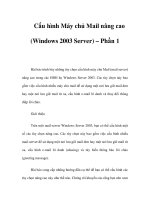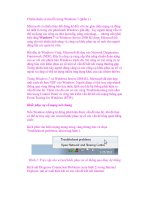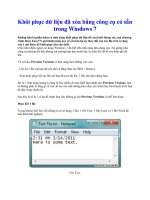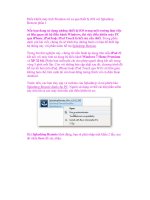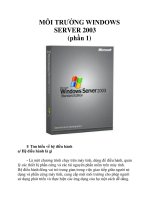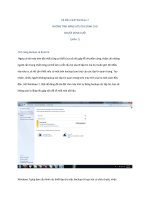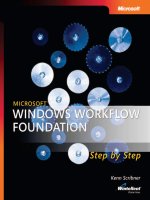WINDOWS 2000 TROUBLE SHOOTING TCP/I P phần 1 pps
Bạn đang xem bản rút gọn của tài liệu. Xem và tải ngay bản đầy đủ của tài liệu tại đây (846.82 KB, 74 trang )
FREE Monthly
Technology Updates
One-year Vendor
Product Upgrade
Protection Plan
FREE Membership to
Access.Globalknowledge
Debra Littlejohn Shinder, MCSE, MCP+I, MCT
Thomas W. Shinder, M.D., MCSE, MCP+I, MCT
TROUBLESHOOTING
WINDOWS 2000
“This book is an important ally in
keeping your Windows 2000 TCP/IP
network running smoothly.”
—Excerpt from Foreword by
Ted Rohling,
Chief Technical Officer
Decision Networks, Inc.
TCP/IP
91_FP.qx 11/28/00 4:09 PM Page 1
With over 1,000,000 copies of our MCSE, MCSD, CompTIA, and Cisco
study guides in print, we have come to know many of you personally. By
listening, we've learned what you like and dislike about typical computer
books. The most requested item has been for a web-based service that
keeps you current on the topic of the book and related technologies. In
response, we have created
, a service that
includes the following features:
■ A one-year warranty against content obsolescence that occurs as
the result of vendor product upgrades. We will provide regular web
updates for affected chapters.
■ Monthly mailings that respond to customer FAQs and provide
detailed explanations of the most difficult topics, written by content
experts exclusively for
■ Regularly updated links to sites that our editors have determined
offer valuable additional information on key topics.
■ Access to “Ask the Author”™ customer query forms that allow
readers to post questions to be addressed by our authors and
editors.
Once you've purchased this book, browse to
www.syngress.com/solutions.
To register, you will need to have the book handy to verify your purchase.
Thank you for giving us the opportunity to serve you.
91_tcpip_FM.qx 2/28/00 10:58 AM Page i
91_tcpip_FM.qx 2/28/00 10:58 AM Page ii
WINDOWS 2000
TCP/IP
TROUBLESHOOTING
91_tcpip_FM.qx 2/28/00 10:58 AM Page iii
Syngress Media, Inc., the author(s), and any person or firm involved in the writing, editing, or produc-
tion (collectively “Makers”) of this book (“the Work”) do not guarantee or warrant the results to be
obtained from the Work.
There is no guarantee of any kind, expressed or implied, regarding the Work or its contents. The Work
is sold AS IS and WITHOUT WARRANTY. You may have other legal rights, which vary from state to
state.
In no event will Makers be liable to you for damages, including any loss of profits, lost savings, or other
incidental or consequential damages arising out from the Work or its contents. Because some states do
not allow the exclusion or limitation of liability for consequential or incidental damages, the above limi-
tation may not apply to you.
You should always use reasonable case, including backup and other appropriate precautions, when
working with computers, networks, data, and files.
Syngress Media® and Syngress® are registered trademarks of Syngress Media, Inc. “Career Advancement
Through Skill Enhancement™” is a trademark of Syngress Media, Inc. Brands and product names men-
tioned in this book are trademarks or service marks of their respective companies.
KEY SERIAL NUMBER
001 MBN123WER6
002 BUT432GHPL
003 VTR987EDXA
004 LKN567YTG7
005 QQWZA2BNM9
006 183ABC7891
007 VCRTED1984
008 CRTY1534XX
009 MNPPP19875
010 XXCVB98345
PUBLISHED BY
Syngress Media, Inc.
800 Hingham Street
Rockland, MA 02370
Troubleshooting Windows 2000 TCP/IP
Copyright © 2000 by Syngress Media, Inc. All rights reserved. Printed in the United States of America.
Except as permitted under the Copyright Act of 1976, no part of this publication may be reproduced or
distributed in any form or by any means, or stored in a database or retrieval system, without the prior
written permission of the publisher, with the exception that the program listings may be entered,
stored, and executed in a computer system, but they may not be reproduced for publication.
Printed in the United States of America
1 2 3 4 5 6 7 8 9 0
ISBN: 1-928994-11-3
Copy edit by: Beth Roberts Proofreading by: James Melkonian
Technical edit by: Thomas W. Shinder, M.D. Page Layout and Art by: Emily Eagar and
Index by: Robert Saigh Vesna Williams
Project Editor: Julie Smalley Co-Publisher: Richard Kristof
Distributed by Publishers Group West
91_tcpip_FM.qx 2/28/00 10:58 AM Page iv
We would like to acknowledge the following people for their kindness and
support in making this book possible.
Richard Kristof, Duncan Anderson, Jennifer Gould, Robert Woodruff, Kevin
Murray, Dale Leatherwood, Shelley Everett, Laurie Hedrick, Rhonda
Harmon, Lisa Lavallee, and Robert Sanregret of Global Knowledge, for their
generous access to the IT industry’s best courses, instructors and training
facilities.
Ralph Troupe and the team at Rt. 1 Solutions for their invaluable insight
into the challenges of designing, deploying and supporting world-class
enterprise networks.
Karen Cross, Kim Wylie, Harry Kirchner, John Hays, Bill Richter, Michael
Ruggiero, Kevin Votel, Brittin Clark, Sarah Schaffer, Luke Kreinberg, Ellen
Lafferty and Sarah MacLachlan of Publishers Group West for sharing their
incredible marketing experience and expertise.
Peter Hoenigsberg, Mary Ging, Caroline Hird, Simon Beale, Julia Oldknow,
Kelly Burrows, Jonathan Bunkell, Catherine Anderson, Peet Kruger, Pia
Rasmussen, Denelise L'Ecluse, Rosanna Ramacciotti, Marek Lewinson,
Marc Appels, Paul Chrystal, Femi Otesanya, and Tracey Alcock of Harcourt
International for making certain that our vision remains worldwide in
scope.
Special thanks to the professionals at Osborne with whom we are proud to
publish the best-selling Global Knowledge Certification Press series.
v
Acknowledgments
91_tcpip_FM.qx 2/28/00 10:58 AM Page v
At Global Knowledge we strive to support the multiplicity of learning styles
required by our students to achieve success as technical professionals. As
the world's largest IT training company, Global Knowledge is uniquely
positioned to offer these books. The expertise gained each year from pro-
viding instructor-led training to hundreds of thousands of students world-
wide has been captured in book form to enhance your learning experience.
We hope that the quality of these books demonstrates our commitment to
your lifelong learning success. Whether you choose to learn through the
written word, computer based training, Web delivery, or instructor-led
training, Global Knowledge is committed to providing you with the very
best in each of these categories. For those of you who know Global
Knowledge, or those of you who have just found us for the first time, our
goal is to be your lifelong competency partner.
Thank your for the opportunity to serve you. We look forward to serving
your needs again in the future.
Warmest regards,
Duncan Anderson
President and Chief Executive Officer, Global Knowledge
vi
From Global Knowledge
91_tcpip_FM.qx 2/28/00 10:58 AM Page vi
vii
Debra Littlejohn Shinder (MCSE, MCP+I, MCT) is an
instructor in the AATP program at Eastfield College, Dallas
County Community College District, where she has taught
since 1992. She is Webmaster for the cities of Seagoville and
Sunnyvale, TX, as well as the family Web site at
www.shinder.net. She and her husband, Dr. Thomas W.
Shinder, provide consulting and technical support services to
Dallas area organizations. She is also the proud mother of
daughter, Kristen, who is currently serving in the U.S. Navy in
Italy, and son, Kris, who is a high school chess champion. Deb
has been a writer for most her life, and has published
numerous articles in both technical and non-technical fields.
She can be contacted at
Thomas W. Shinder, M.D. (MCSE, MCP+I, MCT) is a technology
trainer and consultant in the Dallas-Ft. Worth metroplex. Dr.
Shinder has consulted with major firms including Xerox, Lucent
Technologies and FINA Oil, assisting in the development and
implementation of IP-based communications strategies. Dr.
Shinder attended Medical School at the University of Illinois in
Chicago, and trained in Neurology at the Oregon Health
Sciences Center in Portland, Oregon. His fascination with
interneuronal communication ultimately melded with his
interest in internetworking and led him to focus on Systems
Engineering. Tom works passionately with his beloved wife, Deb
Shinder, to design elegant and cost-efficient solutions for small-
and medium-sized businesses based on Windows NT/2000
platforms.
Contributors
91_tcpip_FM.qx 2/28/00 10:58 AM Page vii
When facing a new operating environment such as Windows
2000, resources such as this book are essential to your
success. Here you will find all the information you need to
understand the new TCP/IP administration tools available in
the Windows 2000 environment. Rather than looking through
countless CDs and volumes of documentation, you can look
here. You will find the helpful hints you need to locate and
troubleshoot the problems you will inevitably face. Experience
and knowledge work together to help you do your job. This
book is an important ally in keeping your Windows 2000
TCP/IP network running smoothly.
Our success as network analysts is often judged by our ability
to find and fix problems. In the past, the process was often a
hit-or-miss proposition made worse by difficult-to-use vendor
documentation. I have spent countless hours with co-workers
just trying to find clues to the nature of a problem because not
enough good information was available. Hopefully this book
will save you from the hit-or-miss approach, immediately
increasing your value as a Windows 2000 network analyst.
Read, highlight, dog-ear, tab, use sticky notes; in short, make
the book yours!
—Ted Rohling, MCP, CCNA, CCDA
Mr. Rohling is the Chief Technical Officer of Decision Networks,
Inc., a computer networks consulting and training company in
San Antonio, Texas. Ted has over 33 years of experience in the
computer and networking field.
Foreword
91_tcpip_FM.qx 2/28/00 10:58 AM Page viii
Contents
ix
Preface xxv
Chapter 1: TCP/IP Overview 1
Introduction 2
TCP/IP’s “Net” Worth 2
More Power, More Flexibility—and More Potential for Problems 4
What’s Ahead in This Chapter 4
TCP/IP: Where It Came From, and Where It’s Going 5
History of the TCP/IP Protocols 5
The Role of the U.S. Department of Defense 6
From ARPAnet to the Internet 7
Another Contender for the Title: The OSI Protocol Suite 8
The Future of TCP/IP 10
Looking Ahead to IPv6 10
Networking Models 14
The Purpose of the Models 15
Why Use Layered Models? 15
The ISO OSI Model 16
Seven Layers of the Networking World 16
Layer 7: The Application Layer 18
Layer 6: The Presentation Layer 19
Layer 5: The Session Layer 20
Layer 4: The Transport Layer 21
Layer 3: The Network Layer 24
Layer 2: The Data Link Layer 25
Layer 1: The Physical Layer 29
The DoD Model 33
The Application/Process Layer 34
The Host-to-Host (Transport) Layer 34
The Internetworking Layer 34
The Network Interface Layer 34
The Microsoft Windows 2000 Networking Model 34
The Application and User Mode Services Component 35
The API Boundary Layer 36
The File System Drivers 37
The TDI Boundary Layer 37
The Network Transport Protocol Component 38
The NDIS Boundary Layer 38
The NDIS Wrapper 38
A Family of Protocols: The TCP/IP Suite 38
Application Layer Protocols 38
FTP 39
SNMP 39
91_TCPIP_TOC.qx 2/25/00 6:21 PM Page ix
x Troubleshooting Windows 2000 TCP/IP • Contents
Telnet 40
SMTP 40
HTTP 41
NNTP 41
Transport Layer Protocols 42
TCP 42
UDP 42
Network Layer Protocols 42
IP 42
ARP and RARP 42
ICMP 43
IGMP 43
TCP/IP Utilities 43
Basic Network Design 44
Planning as Preventative Medicine 44
Testing and Implementation 44
Prototyping 44
Pilot Programs 45
Rollout 46
Summary 47
FAQs 48
Chapter 2: Setting Up a Windows 2000
TCP/IP Network 51
Introduction 52
Designing a New Windows 2000 TCP/IP Network 52
The Planning Team 53
Planning the Hardware Configurations 53
Planning the Physical Layout 54
Diagramming the Network Layout 55
Planning for Sites 56
What Is an Active Directory Site? 56
Planning the Namespace 59
Planning the Addressing Scheme 60
Installing and Configuring Windows 2000 TCP/IP 61
Installing TCP/IP on a Windows 2000 Computer 62
The Protocol Installation Process 63
Configuring TCP/IP 66
Upgrading to Windows 2000 from Windows NT 4.0 68
The Windows NT Domain Models 68
Single Domain 69
Single Master Domain 69
Multiple Master Domains 71
Complete Trust 72
91_TCPIP_TOC.qx 2/25/00 6:21 PM Page x
Windows 2000 Configuration Wizards • Contents xi
Which Model Is Easiest to Upgrade? 73
Other Pre-Upgrade Issues 75
Windows 32-Bit Applications 75
DOS Applications 75
Windows 16-Bit Applications 76
OS/2 and POSIX Application Support in Windows 2000 76
Application Support Summary 77
Common Upgrade Problems 78
Migrating to Windows 2000 from Novell NetWare 78
Understanding the NetWare Implementation of TCP/IP 79
Premigration Issues 80
Using the Directory Services Migration Tool 80
Common Migration Problems 82
Migrating to Windows 2000 from UNIX 82
Understanding the UNIX Implementation of TCP/IP 83
Summoning the Daemons 83
UNIX TCP/IP Utilities 83
Peaceful Coexistence: The Hybrid Network Environment 84
NetWare Interoperability 84
Client Services for NetWare (CSNW) 85
Gateway Services for NetWare (GSNW) 85
NetWare Protocol Support 85
File and Print Services for NetWare 85
Troubleshooter 86
UNIX Interoperability 86
Interoperability with IBM Mainframe Networks 86
Summary 87
FAQs 88
Chapter 3: General Windows 2000 TCP/IP
Troubleshooting Guidelines 91
Introduction 92
The Ten Commandments of Troubleshooting 92
1: Know Thy Network 92
2: Use the Tools of the Trade 93
3: Take It One Change at a Time 93
4: Isolate the Problem 94
5: Recreate the Problem 95
6: Don’t Overlook the Obvious 95
7: Try the Easy Way First 96
8: Document What You Do 96
9: Practice the Art of Patience 97
10: Seek Help from Others 98
Windows 2000 Troubleshooting Resources 99
Microsoft Documentation 99
91_TCPIP_TOC.qx 2/25/00 6:21 PM Page xi
xii Troubleshooting Windows 2000 TCP/IP • Contents
Help Files 100
Resource Kits 101
White Papers 102
TechNet 103
Newsgroups 104
Third-Party Documentation 105
Internet Mailing Lists 105
Usenet Newsgroups 106
Web Resources 106
General Troubleshooting Models 107
Differential Diagnosis Model 108
Examination 108
Diagnosis 109
Treatment 109
Follow-Up 109
SARA Model 110
Scanning 110
Analysis 111
Response 111
Assessment 112
Putting the Models to Work for You 112
The Information-Gathering Phase 112
Questions to Ask 112
Question Format 113
Log Files 117
Application Log 117
System Log 117
Security Log 120
Tools of the Trade 122
The Problem Isolation Phase 122
Organizing and Analyzing the Information 123
Setting Priorities 125
Prioritizing the Problems 126
Prioritizing the Solutions 126
Taking Corrective Measures 127
One Change at a Time 127
Order of Implementation 127
Monitoring Results 127
Using Forms and Check lists 128
Summary 131
FAQs 133
Chapter 4: Windows 2000 TCP/IP Internals 135
Introduction 136
RFC Compliance 136
Enhancements to the TCP/IP Stack in Windows 2000 138
RFC 1323: TCP Extensions for High Performance 140
91_TCPIP_TOC.qx 2/25/00 6:21 PM Page xii
Windows 2000 Configuration Wizards • Contents xiii
Scalable TCP Window Size 140
TCP Timestamps 150
RFC 2018: SACK (Selective Acknowledgment) 152
RFC 1577: IP over ATM 153
RFC 2001: TCP Fast Retransmit 155
RFCs 2211 and 2212: Quality of Service 156
RFC 2205: Resource Reservation Protocol 157
IPSec 158
Purpose and Uses of IPSec 158
IP Security Options 159
IPSec Configuration 160
IPSec Troubleshooting 161
NDIS 5.0 164
Inside the Windows 2000 Internet Protocol (IP) 165
Classless Inter-Domain Routing 166
Multihoming 167
Problems Related to Multihoming 168
IP Multicasting 169
Multicast Address Range 170
Troubleshooting IP Multicasting 171
Duplicate IP Address Detection 171
Inside the Windows 2000 Transport Protocols (TCP and UDP) 172
Transmission Control Protocol 172
Dead Gateway Detection 173
Delayed Acknowledgments 173
TCP Keep-Alives 174
Avoiding the Silly Window Syndrome 174
User Datagram Protocol 175
Understanding TCP/IP Registry Settings 175
Using the Registry Editing Tools 176
Configuring TCP/IP Behavior through the Registry 178
Creating a New Value 179
Editing Common TCP/IP Registry Values 180
Registry Settings that Should Not Be Edited 181
Summary 182
FAQs 185
Chapter 5: Using Network Monitoring and
Troubleshooting Tools in Windows 2000 187
Introduction 188
Windows 2000 Monitoring Tools 188
Basic Monitoring Guidelines 188
Baselining 188
Documentation 189
Backing Up 189
Analysis 189
91_TCPIP_TOC.qx 2/25/00 6:21 PM Page xiii
xiv Troubleshooting Windows 2000 TCP/IP • Contents
Performance Logs and Alerts 190
Counters 192
Log File Format 196
Alerts 196
Network Monitor 198
Filtering 199
Security Issues 199
Installation 199
Using the Program 199
Capture Window Panes 200
Extra Tools 200
Buffers 202
Collecting Data 204
Filtered Captures 207
Event Viewer 216
Using TCP/IP Utilities 219
PING 219
-t Switch 220
-n Switch 220
-r Switch 220
-i Switch 221
-w Switch 221
Using PING 221
nslookup 223
PATHPING 223
tracert 225
ARP 227
Using ARP 227
Static ARP Cache Entries 227
ipconfig 228
netstat and nbtstat 233
netdiag 238
Using netdiag 239
SNMP 242
What SNMP Does 242
Installing the Agent 244
Using IPSec Encryption 250
Network Management Programs 250
Microsoft Systems Management Server 250
NTManage 251
Summary 251
FAQs 252
Chapter 6: Troubleshooting Windows 2000
NetBIOS Name Resolution Problems 257
Introduction to Name Resolution Services 258
NetBIOS Name Resolution 258
91_TCPIP_TOC.qx 2/25/00 6:21 PM Page xiv
Troubleshooting Windows 2000 TCP/IP • Contents xv
Windows 2000 Methods of NetBIOS Name Resolution 261
NetBIOS Name Cache 261
NetBIOS Name Server 262
Broadcast 263
LMHOSTS 263
HOSTS 265
DNS Server 266
The Order of NetBIOS Resolution 266
B-Node 266
P-Node 267
M-Node 267
H-Node 268
The Windows 2000 Windows Internet Name Service (WINS) 271
NetBIOS Name Registration 271
NetBIOS Name Query Request 273
NetBIOS Name Release 274
Multihomed Computers and WINS 274
WINS Proxy Agents 275
WINS Configuration Issues 276
Static Mappings 276
WINS Replication 277
Partnership Agreements 278
WINS Partner Autodiscovery 281
WINS Network Topologies 282
Spoke and Hub topology 283
Push and Pull Partnerships 283
Backing Up the WINS Database 288
Scavenging the Database 290
Interactions with DNS Servers 290
Pointing WINS Servers to Themselves 296
The Browser Service, WINS and Multihomed Masters 299
Windows 2000 WINS Enhancements 302
Persistent Connections 302
Manual Tombstoning 302
Is WINS Ever Going to Go Away? 305
Troubleshooting Common NetBIOS Communication Problems 306
Summary 309
Don’t Multihome Your WINS Server 309
Use a WINS Proxy Agent on Segments with non-WINS Clients 310
Avoid Static Records in the WINS Database 310
Define Replication Partners Based on Link Factors 310
Avoid Split Registration 311
Use the Hub and Spoke Model in Multisite Environments 311
Configure DNS Servers to Resolve NetBIOS Names 311
Don’t Multihome Master Browsers 311
Use Manual Tombstoning Instead of Deleting Records 312
Consider the Ramifications before Disabling NetBT 312
FAQs 313
91_TCPIP_TOC.qx 2/25/00 6:21 PM Page xv
xvi Troubleshooting Windows 2000 TCP/IP • Contents
Chapter 7: Troubleshooting
Windows 2000 DNS Problems 317
Introduction 318
The Difference between NetBIOS Names and Host Names 319
Flat versus Hierarchical Namespace 319
NetBIOS on a TCP/IP Network 320
Characteristics of Host Names 321
The Need for a Name Resolution Service 321
Domains: The “Family Name” 321
The Domain Name System 322
A Hierarchical Naming System 322
Domain Levels 323
Fully Qualified Domain Names 324
Host Name Resolution 329
Name Resolution Sequence 329
The Caching Resolver 329
Using the HOSTS File for Name Resolution 331
Sending the DNS Query to a DNS Server 332
The Recursion Process 333
UNC Paths and DNS Queries 335
Connecting over the Internet via UNC 335
Qualified versus Unqualified Names 336
Appending DNS Suffixes 338
Host Name Resolution via WINS Lookups 338
Multiple DNS Zones and WINs 338
Naming Conventions and Issues 339
Windows 2000 Support for RFC 2181 339
The Controversial Underscore Character 340
Integrity Check 340
Extended Character Set and Zone Transfers 342
Lowercase Only 342
Domain Naming Schemes and Implementation Problems 342
Same Intranet and Internet Domain Name 343
Solution: Separate DNS Zone Databases 343
Different Intranet and Internet Domain Names 345
Advantages of Using Different Internal and
External Domain Names 345
Proxy Configuration 345
Corporate Mergers and Domain Management 345
The Problem: Corporate Merger 346
Proposed Solution 347
Testing the Solution 348
DNS Zone Design and Troubleshooting 350
Standard Zones 352
Zone Transfer 358
Refresh Interval 360
91_TCPIP_TOC.qx 2/25/00 6:21 PM Page xvi
Troubleshooting Windows 2000 TCP/IP • Contents xvii
DNS Notify 361
Request for Information Query 362
Fast Transfer 362
Reverse Lookup Zones 363
The in-addr.arpa Domain 364
Pointer Records 364
Active Directory Integrated Zones 366
Common Problems with Integrated DNS Zones 366
Advantages of Active Directory Integration 367
Zone Delegations 369
Troubleshooting Delegation Problems 370
Special Troubleshooting Issues with Windows 2000 DDNS Servers 371
DNS Security and Internet Intruders 371
Tracking Down the Problem 372
The Solution: Forwarders and Slaves 372
Solving WINS Client Ambiguity with WINS Lookup Zones 373
Setting Up a Dedicated Zone for WINS Referrals 374
Interoperability Problems 376
WINS and WINS-R Incompatibility with BIND Servers 377
DHCP and Resource Record Updates 379
Troubleshooting Tools for Windows 2000 DDNS Servers 380
nslookup 380
ipconfig 382
Event Viewer 382
Network Monitor 383
DNS Trace Logs 386
Performance 387
Summary 390
FAQs 394
Chapter 8: Troubleshooting Windows 2000
IP Addressing Problems 397
Introduction 398
How IP Addressing Works 399
Logical IP Addresses versus Physical MAC Addresses 399
What an IP Address Represents 400
Subnet Masking 403
Determining Address Class 405
How Network IDs Are Assigned 408
How Host IDs Are Assigned within the Network 408
Private versus Public Addresses 413
How IP Addresses Are Used in Network Communications 414
A Map for the Mail Carrier 415
Getting from the Logical to the Physical 415
Putting It All Together 417
IP Communications on a Nonrouted Network (within the Subnet) 417
IP Communications on a Routed Network (to a Remote Subnet) 418
91_TCPIP_TOC.qx 2/25/00 6:21 PM Page xvii
xviii Troubleshooting Windows 2000 TCP/IP • Contents
Overview: IP Addressing Configuration Errors 420
Duplicate IP Addresses 420
Locating the Other Computer that Is Using the Address 421
Address Conflicts with Computers Using DHCP 422
Invalid IP Addresses 422
DHCP Configuration Problems 423
How DHCP Works: Condensed Version 423
Common DHCP Problems 425
Server Configuration Problems 426
Client Configuration Problems 443
Other Common DHCP Problems 444
Automatic Addressing (APIPA) 446
How to Disable APIPA 447
Hardware Address Problems 448
Duplicate MAC Addresses 448
Troubleshooting Subnetting Problems 448
Why Divide the Network? 449
Subnetting Scenario 1 450
Subnetting Scenario 2 450
Subnets 450
Subnet Masks 451
ANDing 451
Tricking IP 452
Making the Mask 452
Subnet Masking for a Class A Network 452
Subnet Masking for a Class B Network 455
Subnet Masking for a Class C Network 457
Errors in Subnet Masking 459
Summary 460
FAQs 463
Chapter 9: Troubleshooting Remote
Access in a Windows 2000 TCP/IP Network 465
Introduction 466
Overview of Windows 2000 Remote Access Services 467
Types of Remote Access 467
Distinguishing between Remote Access and Remote Control 468
Establishing a Remote Access Connection 470
Software Needed for a Remote Access Connection 470
The WAN Link 471
The Remote Access Protocols 482
Serial Line Internet Protocol 484
The Point-to-Point Protocol 484
Preventing Problems Related to the WAN Protocol 486
Understanding Encapsulation 486
Tools for Troubleshooting PPP Connections 487
Using Network Monitor for PPP Analysis 487
91_TCPIP_TOC.qx 2/25/00 6:21 PM Page xviii
Troubleshooting Windows 2000 TCP/IP • Contents xix
Enabling PPP Event Logging 487
Enabling PPP Tracing 487
Troubleshooting Remote Access Configuration Problems 489
Remote Access Server Problems 489
Inability to Establish a Remote Access Connection with the Server 489
Inability to Aggregate the Bandwidth of Multiple Telephone Lines 492
Inability to Access the Entire Network 494
Client Configuration Problems 494
Inability to Establish a Remote Connection 494
Troubleshooting Remote Access Policy Problems 496
Determining Which Multiple Policy Is Causing the Problem 497
Troubleshooting NAT and ICS Configuration Problems 498
The Difference between ICS and NAT 498
Common NAT Configuration Problems 498
Incorrect Public Address Range 500
Incompatible Application Programs 500
Other NAT Problems 501
Troubleshooting VPN Connectivity Problems 502
The Tunneling Protocols 502
PPTP: Point-to-Point Tunneling Protocol 502
L2TP: Layer 2 Tunneling Protocol 502
Troubleshooting VPN Connections 502
Inability to Connect to the Remote Access Server 503
Summary 503
FAQs 505
Chapter 10: Troubleshooting
Windows 2000 Connectivity Problems
at the Network Interface Level 509
Introduction 510
Problems with
Network Interface Card Configuration 510
The Role of the NIC 511
Types of NICs 511
Driver Issues 512
Updating Drivers 512
Problems with Cable and Other Network Media 514
Network Cable Specifications 514
Cable Length Issues 515
The Role of Network Connectivity Devices 516
Understanding Layer 1 and 2 Connectivity Devices 517
How and Why Repeaters and Hubs Are Used 517
How and Why Switches Are Used 521
How and Why Bridges Are Used 523
Understanding Upper-Layer Connectivity Devices 526
91_TCPIP_TOC.qx 2/25/00 6:21 PM Page xix
xx Troubleshooting Windows 2000 TCP/IP • Contents
How Routers Work 526
How and Why Routers Are Used 528
How and Why Brouters Are Used 529
How and Why Layer 3 Switches Are Used 530
How and Why Gateways Are Used 530
Troubleshooting Layer 1 and 2 Connectivity Devices 531
Problems with Repeaters and Hubs 531
The 5-4-3 Rule 531
Passive, Active, and Intelligent Hubs 532
Problems with Passive Hubs 532
Problems with Active Hubs 532
Problems with “Intelligent” Hubs 532
Problems with Bridges 532
Performance Problems 533
Bridge Latency 533
Bridge Looping 533
Network Monitoring Problems 536
Selecting a Connectivity Device 537
Summary 538
FAQs 539
Chapter 11: Troubleshooting Windows 2000
Connectivity Problems at the Internetwork Level 541
Introduction 542
A Routing Example 543
IP Routing Overview 544
Routing Fundamentals 545
Direct Routing 545
Indirect Routing 546
The Default Gateway 547
Routing Interfaces 549
Routing Tables 550
Viewing the Routing Table 550
Understanding the Routing Table 552
Simple Routing Scenario 553
The Windows 2000 Router 553
Routing Protocols 555
How Static Routing Works 555
Characteristics of Static Routing 557
The Dynamic Routing Protocols 558
RIP for IP 558
OSPF 563
Windows 2000 as an IP Router 570
Installing Routing Protocols 571
Windows 2000 Router Management Tools 572
Remote Router Administration 572
Using ICMP Router Discovery 574
91_TCPIP_TOC.qx 2/25/00 6:21 PM Page xx
Troubleshooting Windows 2000 TCP/IP • Contents xxi
Using the Netshell Utility (NETSH) 574
Router Configuration 576
Preconfiguration Check List 576
Configuring Windows 2000 Static IP Routing 577
Troubleshooting Static Routing Configuration 578
Configuring RIP for IP 578
Troubleshooting RIP Configuration 580
Configuring OSPF 581
OSPF Password Protection 583
Windows 2000 Router Logging 583
Using Event Logging 583
Using the Tracing Function 584
Troubleshooting Common Windows 2000 Routing Problems 586
Troubleshooting Static Routing 586
Using PING and TRACERT 586
Using the ROUTE Command 586
Static Routing and Routing Loops 586
Troubleshooting RIP for IP 588
Viewing RIP Neighbors 588
Viewing the Routing Table 589
Summary: Common RIP Problems 589
Troubleshooting OSPF 590
Resetting the Windows 2000 Router 591
Summary 591
FAQs 595
Chapter 12: Troubleshooting Selected Services
on a Windows 2000 TCP/IP Network 599
Introduction 600
Troubleshooting IIS Problems 600
Log Files 602
Enabling Site Logging 602
Log File Formats 604
Logging Problems 608
Troubleshooting Web Server Problems 609
Performance Problems 609
Problems with Site Name Resolution 611
Inaccessible Virtual Directories 612
Problems with Hosting Multiple Sites on a Windows 2000 Server 613
Some Clients Unable to Access Site 614
Changing IIS Properties 616
Troubleshooting FTP Server Problems 617
End-User Problems 617
New Connections Not Being Accepted 617
Users Prompted for Username and Password 619
Connection Limit Exceeded 620
Troubleshooting NNTP Server Problems 621
91_TCPIP_TOC.qx 2/25/00 6:21 PM Page xxi
xxii Troubleshooting Windows 2000 TCP/IP • Contents
Using Event Viewer for NNTP Troubleshooting 621
Common NNTP Problems 622
Summary 626
FAQs 628
Chapter 13: Windows 2000 TCP/IP Fast Track 631
Introduction 632
TCP/IP: What It Is (and Isn’t) 632
TCP/IP History and Future in a Nutshell 632
Where TCP/IP Fits into the Networking Models 633
The Members of the Suite 634
Network Design and Planning Issues 635
Design and Setup of a Windows 2000 Network 635
Special Considerations for Windows 2000 Networks 636
Active Directory Sites 636
Active Directory Namespace 636
IP Addressing Scheme 636
Network Design Check List 637
Installing and Configuring the TCP/IP Protocol 637
Special Considerations when Upgrading from NT 4.0 637
Upgrading the Single Domain Model 637
Upgrading the Single Master Domain Model 637
Upgrading the Multiple Master Domain Model 638
Upgrading the Complete Trust Model 638
Upgrade Tools 638
Special Considerations when Migrating from NetWare 639
Migration Problems 639
Special Considerations when Migrating from UNIX 639
Hybrid Networks 639
General Troubleshooting Guidelines 640
Troubleshooting Resources 640
Troubleshooting Models 641
Differential Diagnosis Model 641
SARA Model 641
Information-Gathering Tips 641
Questions to Ask 641
Log Files 642
Organizing Information 642
Forms and Check Lists 642
Inside TCP/IP 643
Windows 2000 Enhancements 643
Inside IP 643
CIDR Support 643
Multihoming 643
IP Multicasting 644
Duplicate Address Detection 644
Inside TCP and UDP 644
91_TCPIP_TOC.qx 2/25/00 6:21 PM Page xxii
Troubleshooting Windows 2000 TCP/IP • Contents xxiii
TCP 644
UDP 644
TCP/IP Registry Settings 645
Network Monitoring Tools 645
Monitoring Guidelines 645
Baselining 645
Documentation 645
Performance Logs and Alerts 645
Network Monitor 646
Capture Filters 646
Display Filters 646
Event Viewer 647
TCP/IP Utilities 647
Name Resolution Problems 647
WINS and NetBIOS Name Resolution 648
DNS and Host Name Resolution 649
Resolving Host Names to IP Addresses 649
Planning the DNS Namespace 649
Zones 650
Tools 650
IP Addressing Issues 650
The IP Address 650
How IP Addresses Are Assigned 651
ARP 651
Common IP Addressing Errors 652
DHCP 652
Subnetting Problems 653
Remote Access Connectivity 653
Remote Access versus Remote Control 653
Remote Access Links 654
Remote Access Protocols 654
RRAS Configuration Problems 654
Server Configuration 654
Client Configuration 655
Multilink 655
Network Access 655
Remote Access Policy 655
NAT and ICS 655
NAT Configuration 656
Virtual Private Networking (VPN) 656
The Network Interface Level 657
Connectivity Devices 657
Repeaters 657
Hubs 657
Switches 657
Bridges 657
The 5-4-3 Rule 658
The 80/20 Rule 658
91_TCPIP_TOC.qx 2/25/00 6:21 PM Page xxiii
xxiv Troubleshooting Windows 2000 TCP/IP • Contents
Looping 658
The Internetwork Level 658
Routing Tables 659
Features of the Windows 2000 Router 659
Routing Protocols 659
RIP Features 660
OSPF Features 660
Windows 2000 Router Logging 661
Selected Services 661
Site Logging 662
Web Server 662
FTP Server 662
NNTP Server 663
Summary 663
Appendix A: TCP/IP Troubleshooting Secrets 665
Lesser-Known Shortcuts 666
Finding the Consoles 666
Control the Index Server 666
Windows 2000 Telnet Client and Server 667
Telnet Server 668
Under-Documented Features and Functions 670
The FTP Command Set 670
The nslookup Utility 671
Using ipconfig Switches 672
For Experts Only 674
The Future of IP Communications 674
IP Telephony 674
TAPI 3.0 and H.323 675
Telephony and Active Directory 675
Planning the Transition to IPv6 676
How Is IPv6 Different? 676
The Scary Part 676
How to Prepare for the Transition 677
Securing IP: IPSec 677
End-to-End Security 677
IPSec Functions 678
Security Troubleshooting 678
Tunnel Mode 678
IPSec and NAT 679
Index 681
91_TCPIP_TOC.qx 2/25/00 6:21 PM Page xxiv


